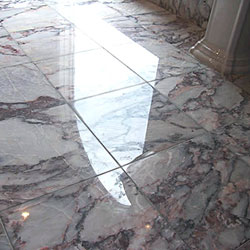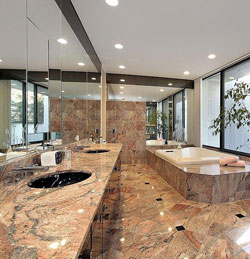 Topical coating is an application of natural or synthetic waxes, acrylics, urethanes and epoxies over the marble floor. The majority used today are composed of acrylics. Such applications usually call “maintenance of marble surfaces”.
Topical coating is an application of natural or synthetic waxes, acrylics, urethanes and epoxies over the marble floor. The majority used today are composed of acrylics. Such applications usually call “maintenance of marble surfaces”.
In actuality, topical coating is simply replacing the polished marble floor with a film of reflective and shiny plastic polymers, which are designed to wear and be refinished over time. In reality, this is a system of maintaining the plastic, not the stone. It is a finish designed to gradually wear under traffic or what is referred to in the industry as a “sacrificial coating”. The plastic finishes many times contain chemicals that further damage the stone. The strippers and harsh pads used periodically to reduce the finishes and replace the glossy surface also do mechanical damage to the underlying stone.


 Marble is a metamorphic rock resulting from the metamorphism of limestone. Metamorphism can be defined as the solid state recrystallization of pre-existing rocks due to changes in heat and/or pressure and/or introduction of fluids. This metamorphic process causes a complete recrystallization of the original rock into an interlocking mosaic of calcite and/or dolomite crystals.
Marble is a metamorphic rock resulting from the metamorphism of limestone. Metamorphism can be defined as the solid state recrystallization of pre-existing rocks due to changes in heat and/or pressure and/or introduction of fluids. This metamorphic process causes a complete recrystallization of the original rock into an interlocking mosaic of calcite and/or dolomite crystals. The deep shine we see on polished stone is achieved by rubbing the stone with a series of abrasive materials. The process is very similar to sanding a piece of wood. The stone is rubbed with a coarse abrasive grit, followed by finer and finer grits until the stone becomes smooth. The scratches left behind from one grit are removed by the next, creating finer and finer scratches. The process continues until the scratches are microscopic. The shine on the stone is achieved by abrading the surface to the point at which it becomes extremely smooth and starts to develop some reflectivity. The shine on the stone is thus a product of optics. This same optical property can be observed on a pond. When the wind is blowing and the surface of the pond is wavy, it becomes difficult to see a reflection; when the air is still and the pond is calm, a deep reflection can be observed. So in order to achieve a deep shine on your stone all that really needs to be done is to smooth it until it shines.
The deep shine we see on polished stone is achieved by rubbing the stone with a series of abrasive materials. The process is very similar to sanding a piece of wood. The stone is rubbed with a coarse abrasive grit, followed by finer and finer grits until the stone becomes smooth. The scratches left behind from one grit are removed by the next, creating finer and finer scratches. The process continues until the scratches are microscopic. The shine on the stone is achieved by abrading the surface to the point at which it becomes extremely smooth and starts to develop some reflectivity. The shine on the stone is thus a product of optics. This same optical property can be observed on a pond. When the wind is blowing and the surface of the pond is wavy, it becomes difficult to see a reflection; when the air is still and the pond is calm, a deep reflection can be observed. So in order to achieve a deep shine on your stone all that really needs to be done is to smooth it until it shines.







